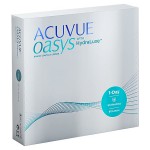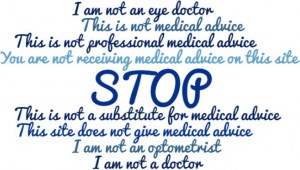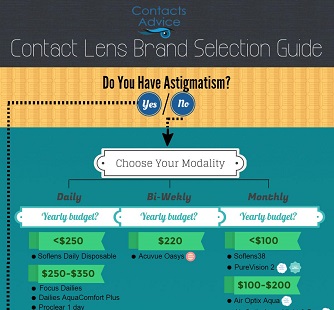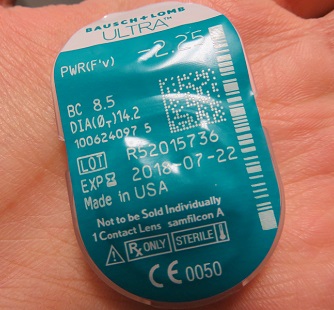When I was 23, I had already been wearing contact lenses for 8 years. At the time, I wasn’t getting regular eye exams, I would just re-purchase my contact lenses whenever I ran out. One day, I had to visit my eye doctor because I was beginning to see blurry out of my right contact lens. I thought it was merely that my prescription had changed, but it was actually something slightly more sinister than that…
I am not a doctor. The information provided on this page is for general educational purposes only. You are not receiving medical advice or being prescribed contact lenses on this page. Please read Contacts Advice Terms of Use before continuing.
 It turns out that I was over-wearing my contact lenses, and over the years, it was causing an increasing amount of irritation to my cornea. This kind of irritation is not usually felt, making it extremely difficult to notice that it’s happening on your own, but as it gets worse, it causes more and more cloudiness in your vision.
It turns out that I was over-wearing my contact lenses, and over the years, it was causing an increasing amount of irritation to my cornea. This kind of irritation is not usually felt, making it extremely difficult to notice that it’s happening on your own, but as it gets worse, it causes more and more cloudiness in your vision.
The eye doctor had to take me out of contact lenses for several weeks and treat my corneal irritation before I was finally sent to be re-fitted into a higher quality contact lens brand to lower the chance of it happening again.
Unfortunately, what happened to me is just one of many examples where this kind of thing happens. Wearing contact lenses is perfectly safe, and does not create health problems in the long run, as long as certain rules are respected. In this article, I want to share some tips with you that can potentially help you prevent problems that might require you to drop out of contact lenses.
Avoid Contact Lens Over-Wear
Contact lenses are not meant to be worn for every waking hour of the day, every day of the week. Under normal circumstances, it is best to stick to at most 10-12 hours per day, and at most 5-6 days per week. This will vary depending on your situation.
The length of time you wear your contact lenses for is especially important if you’re wearing an older brand of contacts. Older brands are generally not as breathable as today’s leading brands, and they tend to dry out faster. This causes reduced oxygen levels to the cornea, and increased friction, which is the perfect recipe for contact lens complications.
Upgrade To A High Quality Contact Lens Brand
Every year, new studies reveal causes of contact lenses complications that we were previously unaware of, new research reveals better ways of making contact lenses, and advances in technology allows manufacturers put everything into production.
Which means that if you’re still using a contact lens brand that’s based on dated research and technology, your eyes may suffer as a result in the long run. All contact lenses are not made equal. By staying in older brands year after year, you increase you chance of eventually developing some kind of complication, at which point you may be forced to upgrade, or depending on the severity, to drop out of contacts altogether.
Replace Your Contact Lenses on Time
This is an area when a lot of people take liberties with rules governing safe contact lens wear. I am sometimes shocked to find out how long some people extend their lenses for.
There really is no exception to these rules:
- If you wear monthly lenses, throw them out 30 days after you’ve opened the package.
- If you wear bi-weekly lenses, throw them out 14 days after you’ve opened the package.
- If you wear daily disposables, throw them out every day!
It is very tempting for the people who have monthly lenses, but only wear contact lenses occasionally, to keep the lenses for more than 30 days. I completely understand that it may seem like a waste to throw away a pair of monthly lenses if you’ve only worn them once or twice in that month. But they were only designed to last that long whether they are worn or not. If you’re in this situation, I would strongly urge you to switch to a daily disposable contact lens brand instead of extending your monthly lenses indefinitely.
Clean Your Lenses Thoroughly
If you wear monthly or bi-weekly contact lenses, you have to rub your lenses with proper contact lens cleaning solution at the end of the day. This is to remove the build up and deposits from your tears onto the contact lenses throughout the day. An accumulation of these deposits can cause discomfort and irritation throughout the day, and in the long run can lead to contact lens intolerance.
If you are really adverse to spending the time to rub your lenses, you can use a contact lens cleaning system that doesn’t require you to rub the lenses at all. These are called hydrogen peroxide systems. They clean your lenses better than a rinse & rub solution, and they save you time. Check out this article for more information on them: Hydrogen Peroxide Contact Lens Solution – Are They For You?
Go For Routine Eye Exams
If you wear contact lenses, you should be seeing your eye doctor once a year to make sure that your prescription is stable and that your contact lenses are not negatively affecting the health of you eyes.
Most of the time when someone develops contact lens complications, it’s someone who hasn’t been seen for a routine eye exam in years. Without yearly eye exams, you don’t know if something is going wrong until it’s too late. Remember that the early, and even mid-stages of contact lens complications don’t produce and obvious symptoms.
I hope that you found this article helpful, and that it will prevent you from developing problems with your contact lenses.





Leave a Reply